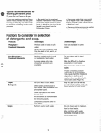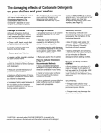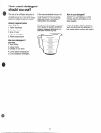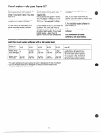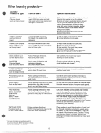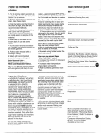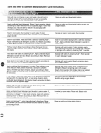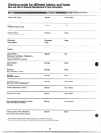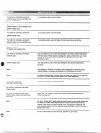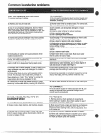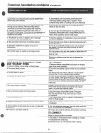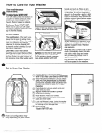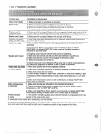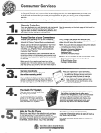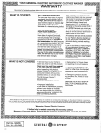
Commonlaunderingproblems
UN-TCmRESIDUE0?$!CLOTHES
‘TOPREVENE
1. Incorrect sorting of clothes. 1. Do not wash lint-producers (such as terry towels and
chenille) with lint-receivers (such as man-made fabrics,
velveteen,corduroy).
2.Washing too long for load size.
2. Shorten wash time for smaller loads. For normal soil,
use 1 min. per pound of dry clothes.
3. Use of non-phosphate detergents. Some of these 3. (a)If possible, use phosphate detergent or liquid
detergents react with hardness minerals in water to detergent.
form a precipitate which can be mistaken for lint. The
(b) Install a water softener to reduce hardness.
precipitate can build up in the fabrics making them
more abrasive and increasirm iint.
(c) Usea warmer wash water.
(d) Usea packaged water softener.
4. Undissolved granular detergent may leave powdery 4.(a)See page 11for recommendations on how to add
residue on fabrics which can be mistaken for lint.
detergent to speed up complete dissolving.
(b) Usea liquid or special cold water detergent.
(c) Predissolve granular detergent in hot water, or make
sure detergent is dissolved completely in wash water
beforeaddingclothes.
(d) Make certain clothes have ample room to move in
washer.
(e)Use a warmer wash water.
5. Overloading of washer will cause abrasion which 5. Wash fewer items in each load. Make sure water
creates excessive lint.
level is correct for size of load.
6. Too much bleach. Over-bleached items, such as 6. Usecorrect amount of bleach according to package
towels, will shed excessive lint.
directions.
7. Not enough detergent. Enough detergent must be
7. Increaseamount of detergent used. Amount is
used to hold lint in suspension during wash cycle.
determined by water hardness, size of load, degree of
soil and amount of water. See Page 11.
8. Incorrect use Gffabric softener. If used in wash cycle,
& Usefabric softeners only in rinse cycle, unless
many softeners may react with detergent to create a
package specifies adding to wash cycle.
white deposit.
9. Pilling. Most likely to occur with polyester-cotton
9. Cannot be preventedor corrected. Caused by normal
blends. The stronger man-made fibers, instead of
wear of the fabric. (Turning clothes inside-out may
breaking off will collect and hoid small bundles of
provide some help).
fibers resulting in “pills.” This “pilling” is normal for
these fabrics and can be mistaken for lint.
10. Over-drying in dryer may cause build-up of static
10. Useof fabric softener at the start of the rinse cycle.
electricity in man-made fabrics, causing lint attraction.
m CORRECV
All of the above causes of residue (except Item 9), can
usually be removed from garments through use of
correct laundry procedures.
SNAGS,HOLES,TEARS,RIPScm
To PREVENT:
EXCESSIVEWEAR
1. Removeall pins, check pockets of all garments
before putting in washer. Also check washer to see if
1. Pins on garments or sharp objects left in pockets. any objects remained in wash tub.
2. Snaps, hooks, sharp buttons, belt buckles, zippers. 2. Makesure all hooks, snaps and buttons are fastened.
Removesharp buttons and belt buckles. This is very
important when washing knits, which snag easily. Turn
knits inside out.
3. Improper use of chlorine bleach. Holes may have
3. (a)Use only correct, measured amount of bleach.
random square shape; yellow discoloration, fabric will
be weak at edges of hole.
(b) Never add undiluted bleach to washer tub nor allow
clothes to come in contact with undiluted bleach. Do
not wipe up bleach spills with clothes.
18



